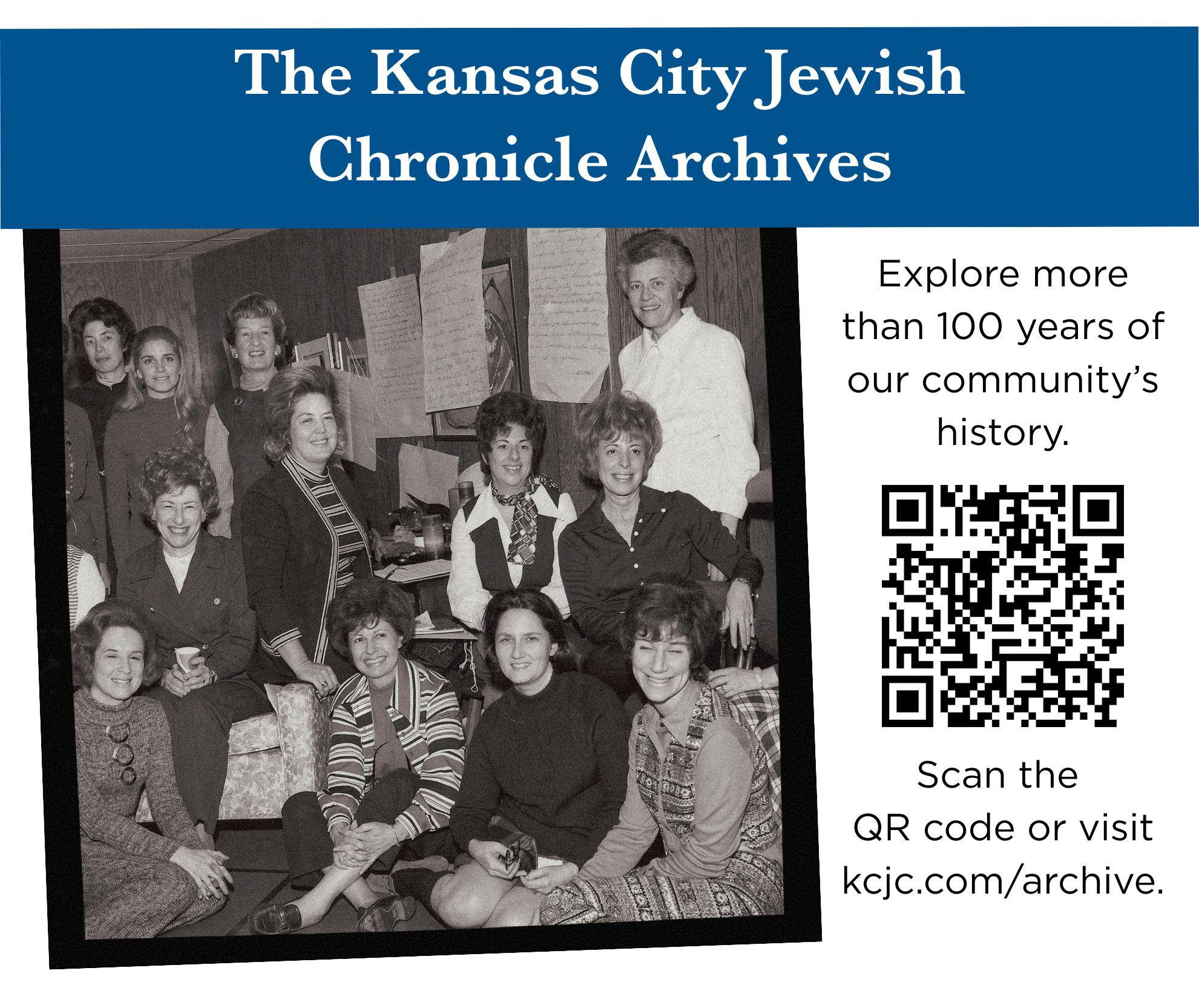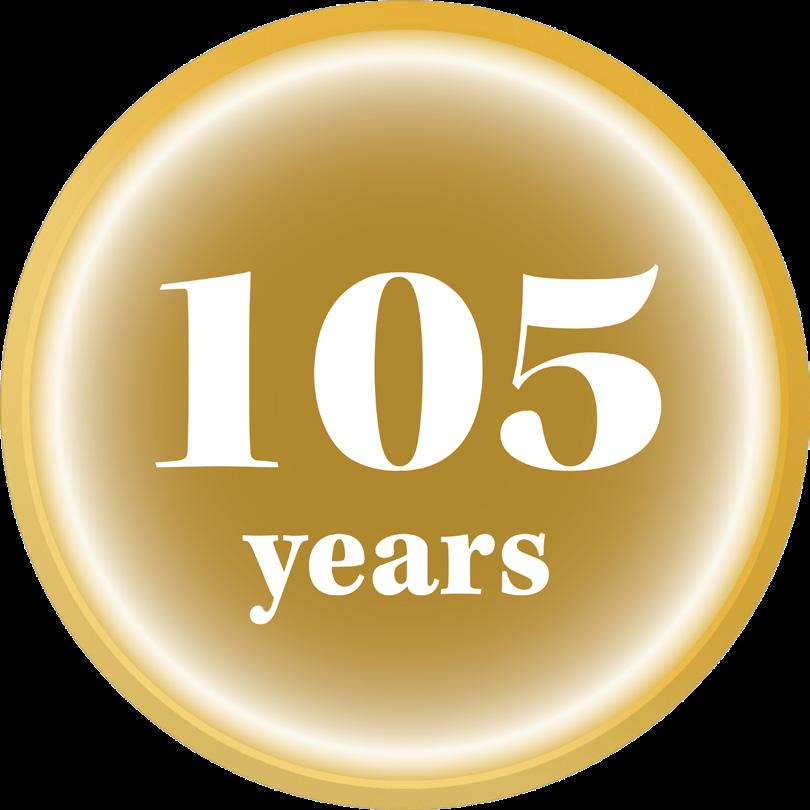
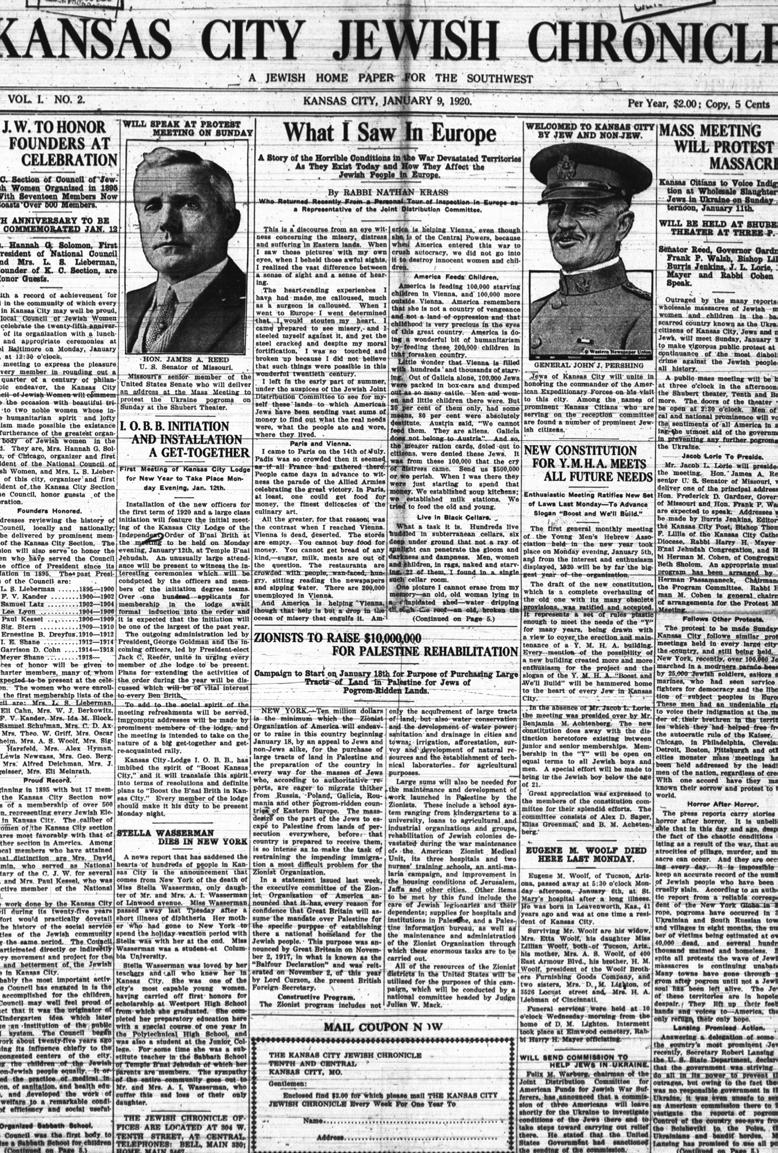
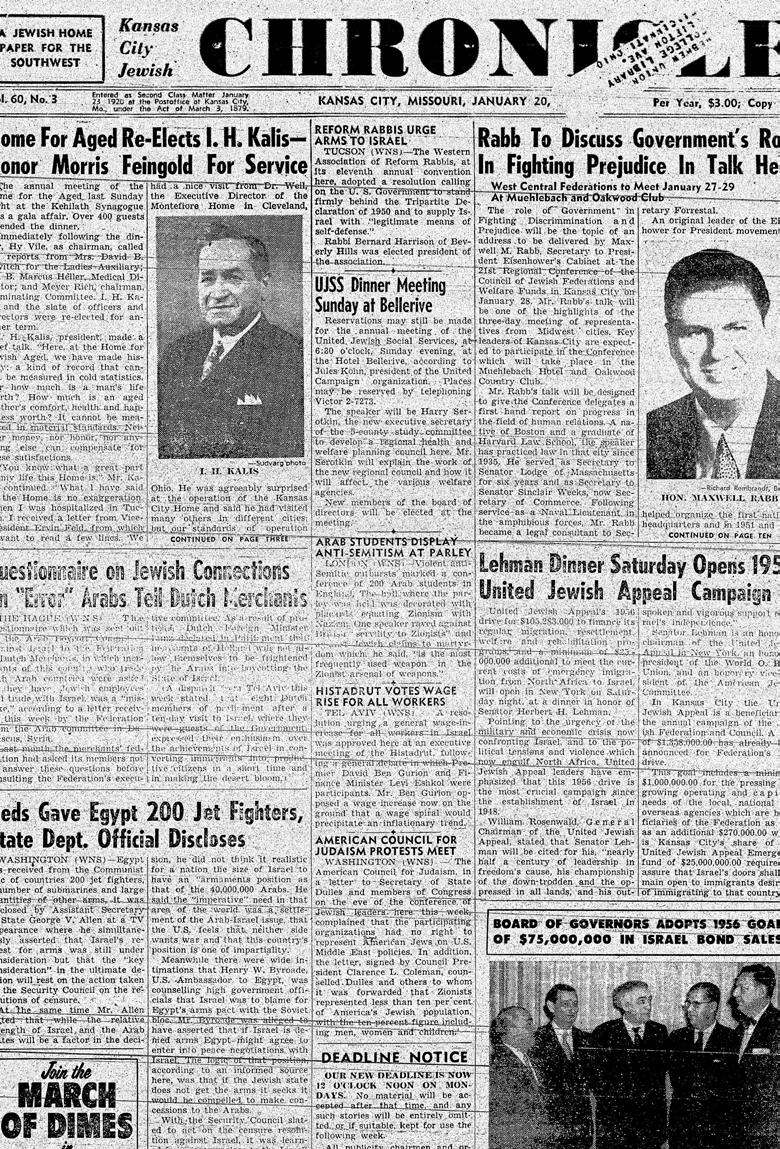
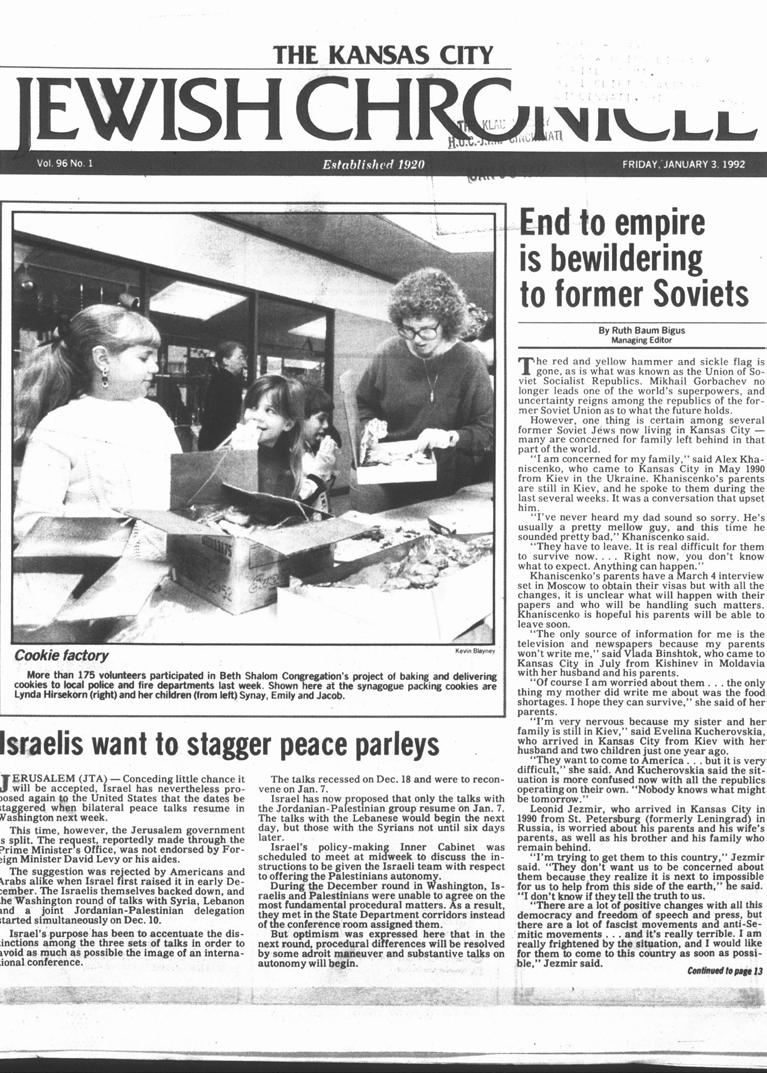













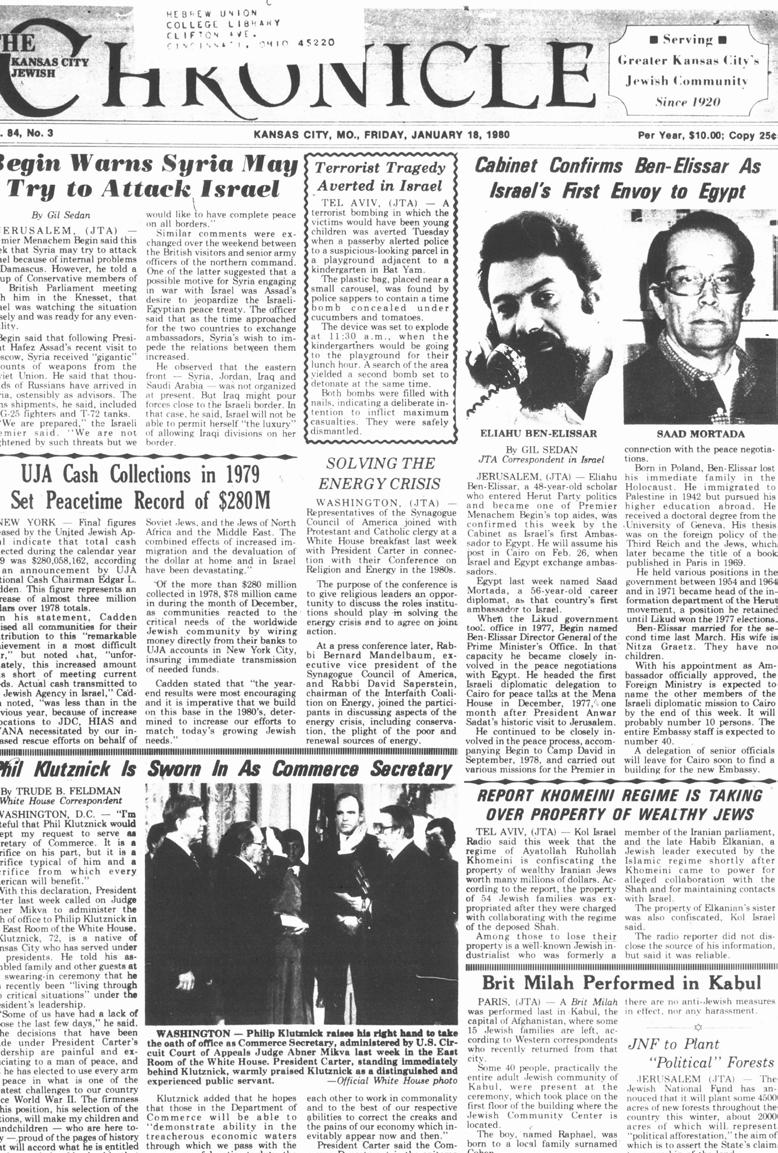

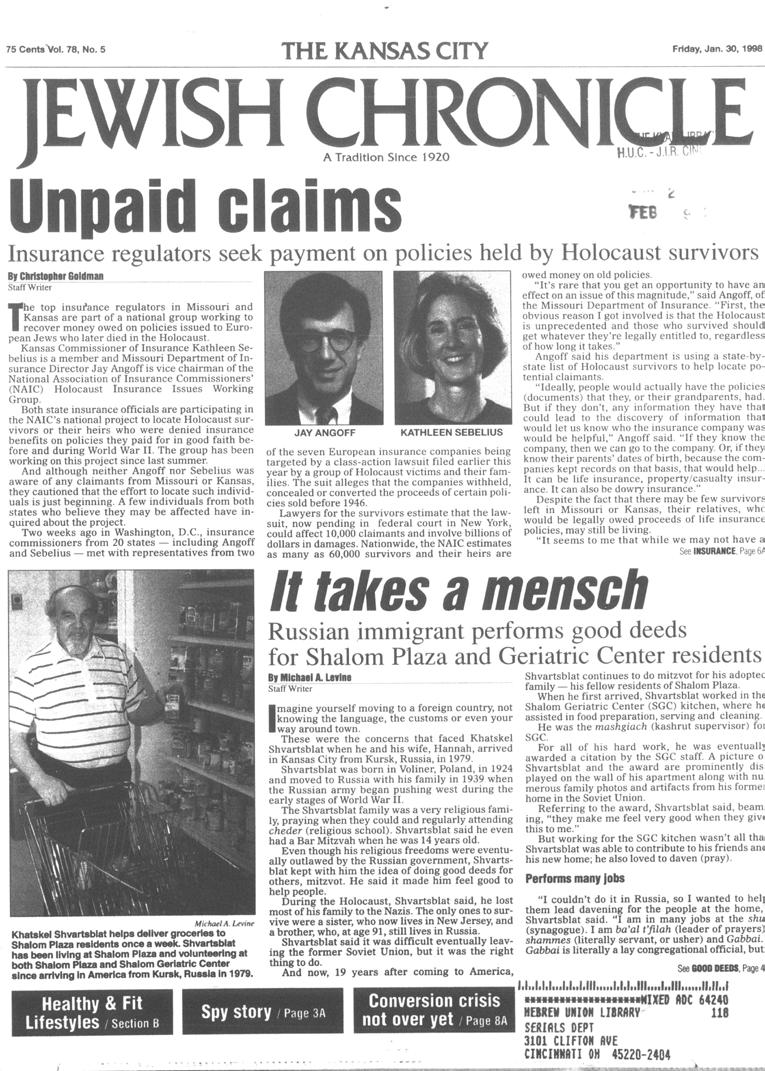










By Derek Gale Vice President and COO of Jewish Federation

It is with great humility and also great pride that I write this column in celebration of 105 years of The Kansas City Jewish Chronicle — many of these years under the stewardship of the Rose family, and only more recently, five years under the stewardship of Jewish Federation of Greater Kansas City.
These last five years have been a whirlwind with many changes, including moving to publishing every other week in print, partnering to create a complete digital archive, and ramping up our digital presence with
social media content, e-newsletters and digital editions. Through it all, we have worked diligently to appreciate our loyal readers and bring you more local content, new features and to maintain The Chronicle as a true community news and information source.
When we spoke with Steve Rose about taking The Chronicle under the Federation umbrella, we assured him we had the right people on our team to do so — people with degrees and working backgrounds in journalism and business. Most of those people remain part of the Federation team today, including Assistant Editor Lacey Storer, who is integral to The Chronicle’s success, strategy and continued evolution. Meanwhile, we have one key addition to the team, who joined us part time in 2021 and full time in 2022, and who has proven his worth many times over: Chronicle
Editor & Business Manager Sam Kricsfeld.
Sam is what makes The Chronicle happen — quite literally. He interviews sources, writes articles, edits, writes headlines, designs the paper, manages subscriptions and — in partnership with Lacey — makes presentations around the community. I spent most of a decade working in journalism before my dozen years at Jewish Federation, and it is rare to find someone who not only can so capably do so much, but also who does it with the passion and dedication that Sam brings to our community.
I am privileged to work as a small part of the team that carries forward The Kansas City Jewish Chronicle brand, writing here or there, serving as a copy editor for our print editions and occasionally offering advice on ethics, budget or best serving our readership.
It gives me great joy to use my graduate education and journalism training in service of our Jewish community.
My pledge to our community is that The Chronicle will continue to be a trusted brand that informs our Jewish community, tells the stories of our community and quite literally chronicles how our community moves through this era of Jewish life. Just like our work at Jewish Federation, there is never a dull moment as we gather, report and share what’s happening in our Jewish community and Jewish world.
If 105 years of The Chronicle resonates with you, and you would like to invest in the future of this community news source, please reach out to me to find out how your investment today can have lasting impact: derekg@jewishkc.org.



YMHA/YWHA (later the
established



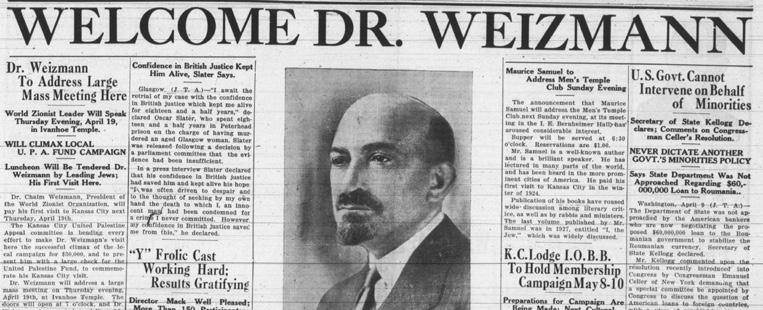
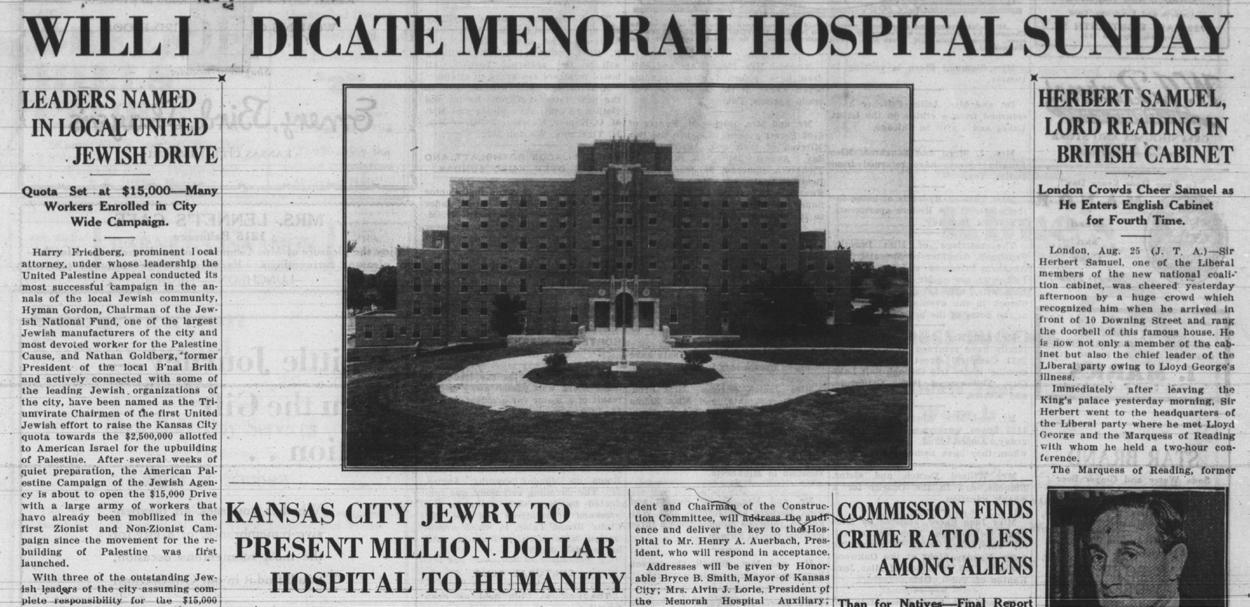


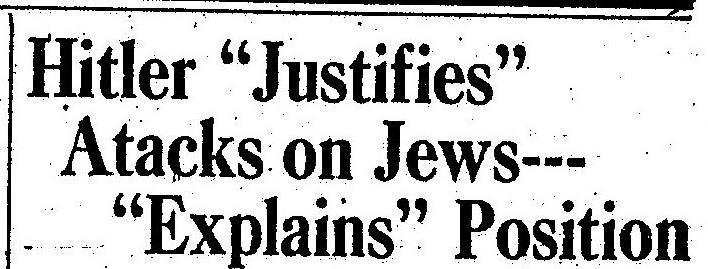
Thisisanabridgedversionofanarticle by Victor Slone, The Chronicle’s first editor and founder, that he wrote for the 50th anniversary issue of The Chronicle(Jan.30,1970).
Here in Miami Beach, Florida, where my wife and I have come to spend our retirement years, the New Year of 1970 brings back memories of old, when a half-century ago I, together with two colleagues, the late Nathan Gould of Milwaukee, Wisconsin, and Elias Rex Jacobs of Buffalo, New York, founded The Kansas City Jewish Chronicle and were among the pioneers in the Midwest in the American Jewish newspaper field.
Gould was already publishing the Detroit Jewish Chronicle when, in 1919, he was intrigued by the promotion of a nationwide campaign by the Chamber of Commerce extolling Kansas City, “The Gateway to the West,” as an ideal community business expansion…
The thought of inaugurating a chain of Jewish newspapers was exciting, but I was frightened about venturing into so extensive an enterprise. I was soon won over, however, as I was journalistically inclined…
In the Kansas City Jewish community of which I was about to become an integral part, I found some situations deplorable. There were three distinctly separate groups — the Orthodox, Conservative and Reform, each uninterested and uncooperative with one another. There prevailed an atmosphere of fear among Jews living in large apartment buildings as to how their Gentile neighbors might react if they saw “Jewish” mail in the mailboxes. “I would like to subscribe if only you would call the paper ‘The Chronicle,’” we were told. Some families in private residences hesitated to subscribe for similar reasons.
These fears proved to be unwar-

ranted. The Kansas City Jewish Chronicle soon became well known throughout the community and was well received. Some non-Jews, unsolicited, became subscribers... It was inevitable that newly developing circumstances would bring about such a change in attitudes, and to me that is the most outstanding achievement which has taken place in this past half-century.
Since neither great wealth nor worldly position was in my prospects when I chose to enter the Jewish newspaper field, I pretty well evaluated myself and my potentials as a businessman. I knew I was not the go-getter type and that it would probably be necessary to devote longer, harder hours to this business of making a living than some others who were more aggressive might require.
This I had calculated correctly.
Working with a most limited staff, too frequently my entire 12-hour day was occupied within the framework of my business requirements. Fortunately, involved was a great deal of reading, which I loved; but, nevertheless, enforced reading under pressure can become irksome.


Since my personal life was to be so inextricably woven with my business life, I could combat drudgery only by working for an ideal, a motive. Everything that is capable of exciting or firing one with enthusiasm can usually sustain one’s energies above ordinary level. To promote better human relations would be my goal and, through our newspaper as a medium, I would strive towards this purpose and hope to be rewarded by the triumph of results.
I never lost awareness of that goal. I loved my work, and though I admit that frequently it was drudgery, through it I found my most powerful stimulus.
Also through my work I made a host of wonderful friends and had the opportunity to meet many interesting local, national and international personalities...
When in June of 1963 I relinquished my business interest and executive responsibilities, I stated that a continuously progressive Kansas City Jewish Chronicle in a thriving, harmonious community would be my greatest reward.



Pictured from The Chronicle archives are (top left) an image of the Young Men’s/Women’s Hebrew Association building from July 11, 1924; (above right) the announcement of the celebration of the Jewish Community Center’s relocation to 82nd and Troost on May 26, 1961; and (above left) the celebration of the opening of the Jewish Community Campus from Nov. 4, 1988.
The Jewish Community Center (and now the Jewish Community Campus as a whole) has been Kansas City Jewry’s main venue for gatherings
for more than a century. Since the Jewish Community Center’s founding as the Young Men’s/Women’s Hebrew Association in 1924, The Chronicle
has consistently shared about its news and events, from its events to its amenities to its youth activities and more.

The front page of the May 14, 1948, issue of The Chronicle heralding the establishment of the State of Israel included the Shehecheyanu prayer in Hebrew and the Israeli Declaration of Independence.
The Kansas City Jewish Chronicle has been unreservedly Zionist since its founding. Up to and since the establishment of the State of Israel, The Chronicle has been steadfast in its support of Jewish self-determination.
Upon the announcement of Israeli independence on May 14, 1948, The Chronicle printed the Shehecheyanu prayer in Hebrew, blessing G-d, “who has kept us alive, sustained us and brought us to this season.” Right
below that, the entirety of the Israeli Declaration of Independence was printed. Throughout the May 14 issue were announcements of celebrations and prayer services held by synagogues and community organizations (including multiple organizations specifically dedicated to Zionism).
For years, especially under Milton Firestone’s editorship, Israeli politics and wars were frequent topics in The

Nuremberg Laws passed in Germany
Nuremberg Laws passed in Germany
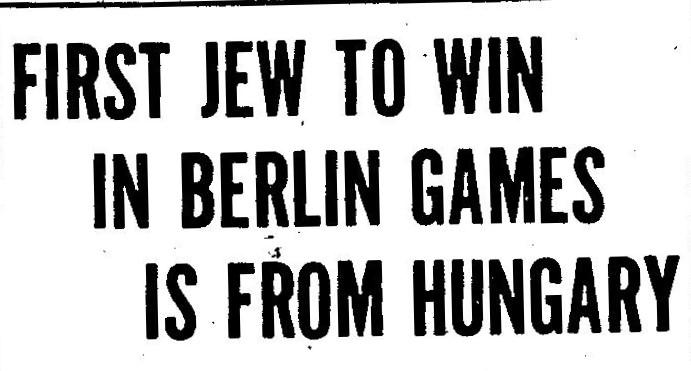
Nazi Germany hosts Olympics
Chronicle. Multiple Chronicle editors frequently traveled to Israel to report, and there were even Israeli correspondents who wrote specifically for The Chronicle (most prolifically, Sybil Kaplan).
Since the advent of 24-hour news and the internet, The Chronicle has pivoted towards reporting on the Kansas City community’s relationship with Israel more than its politics and wars.

Nazi Germany hosts Olympics KristallnachtKristallnacht
Rabbinical Association formed
Germany invades Poland

Nazis begin mass murders of Jews
Nazis begin mass murders of Jews
Attacks on Pearl Harbor; U.S. enters World War II Warsaw Ghetto uprising Warsaw Ghetto uprising


Jewish Community Relations Bureau established
President Harry S. Truman assumes office after death of FDR

Germany surrenders, followed by Japan after nuclear bombing, ending World War II

State of Israel established

Jewish Vocational Service established

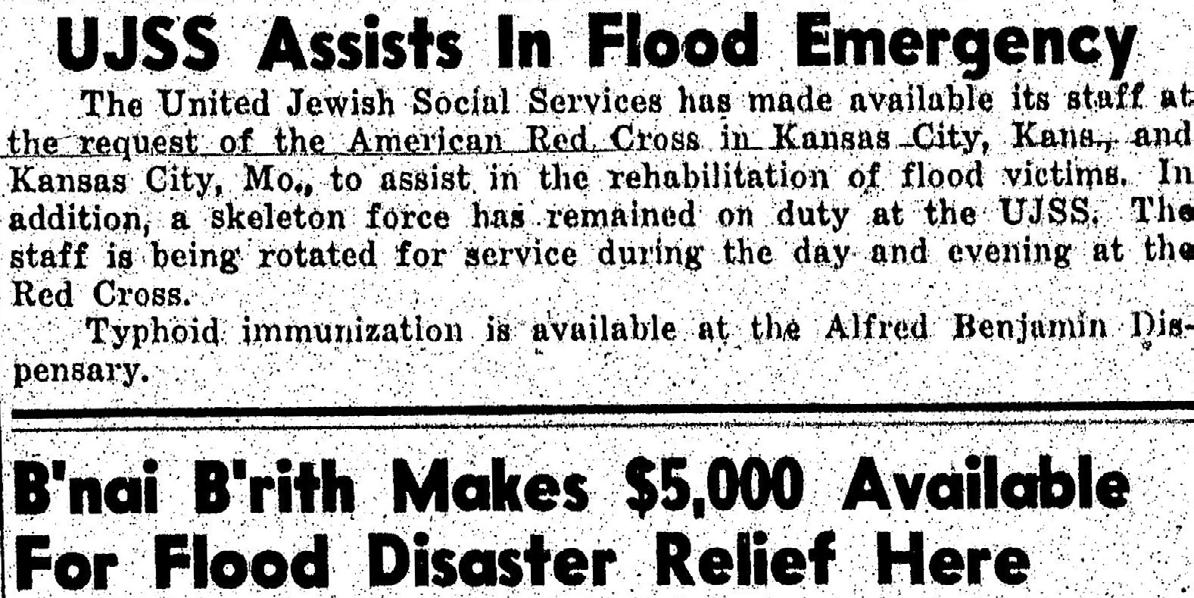

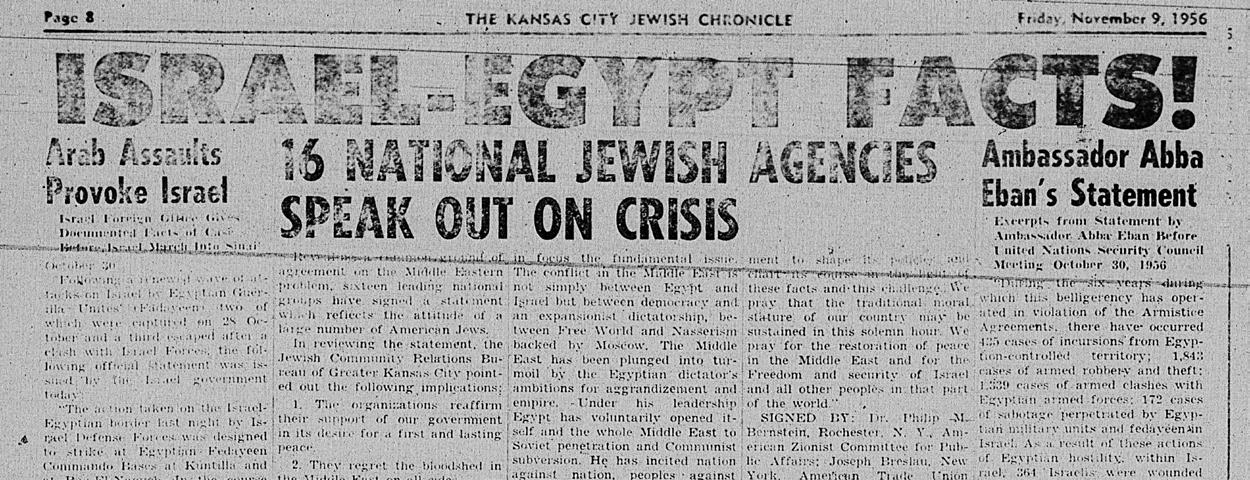

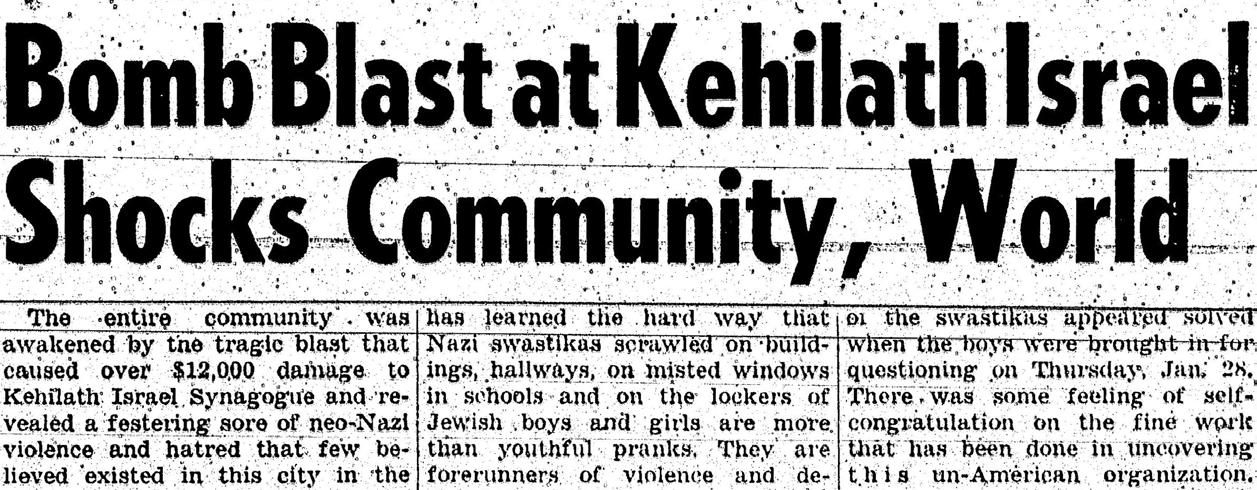
For 20 years, from 1963-1983, Milton Firestone was the dedicated steward of The Kansas City Jewish Chronicle, elevating its status to rival Jewish publications across the nation. Due to his unexpected death at age 55, he was never able to pen a retrospective on his career. Therefore, the following biography is assembled from the obituaries and memorials published in The Chronicle after his death.
Upon becoming The Chronicle’s editor and partial owner in 1963, Milton Firestone wrote that The Chronicle should “continue to be a unifying influence in our Jewish community, thereby helping to counteract the centrifugal forces that tend to divide us.”
Firestone also was responsible for some of the region’s best Israel reporting — in 1967, shortly before the Six-Day War, he and his wife, Bea, traveled to Israel on a reporting trip. Firestone returned five more times, accompanying Israeli troops to Beirut, Lebanon, during Israel’s invasion.
In addition to his dedication to reporting, Firestone was deeply engaged with the paper’s production, involving himself in layout and copy editing.
Born in New York City in 1927, Firestone and his family moved to Kansas City the following year. His dedication to Judaism was cemented in his youth; he was involved in Congregation Beth Shalom’s religious school, and while at the University of Kansas, he served as president of the Jewish Student Union.
After his service in the Korean War, he married Bea Blumenthal


and worked at Columbia Glass and Window Co. until he purchased The Chronicle in 1963. Upon his purchase, he also became editor.
In 1966, he and Bea helped establish what would become Hyman Brand Hebrew Academy, serving on its boards and using The Chronicle to garner support.
In addition to his leadership at HBHA, he was involved with the American Jewish Press Association, Society of Professional Journalists, Congregation Beth Shalom, B’nai B’rith Lodge, the NAACP and more. Congregation Beth Shalom’s Rabbi Morris Margolies wrote in The Chronicle upon Firestone’s death that “he [revived the paper] by publishing the most significant Jewish news on the world scene. He did it by supporting every constructive Jewish enterprise in our community. He did it with an editorial fearlessness… for Israel no American Jew has had greater love.”
Stan Rose, then publisher of The
Chronicle, wrote that Firestone “was The Kansas City Jewish Chronicle. Milton lived and breathed it, and next to his family, The Chronicle was the most important thing in his life… No one will ever surpass his dedication and skill in interpreting Kansas City Jewish life and the events and values that are so important to our community.”
Upon his untimely death at age 55 from a heart attack, his wife, Bea, essentially became the acting editor of The Chronicle until Stan and Steve Rose’s Sun Publications bought the paper and Firestone’s successor, Diane Wolkow, was named managing editor.
Firestone’s dedication to the paper and deep involvement in Jewish journalism and the Kansas City Jewish community makes him one of the community’s best-remembered leaders of his era. For years after his death, Firestone was still listed among the staff of The Chronicle in memoriam.








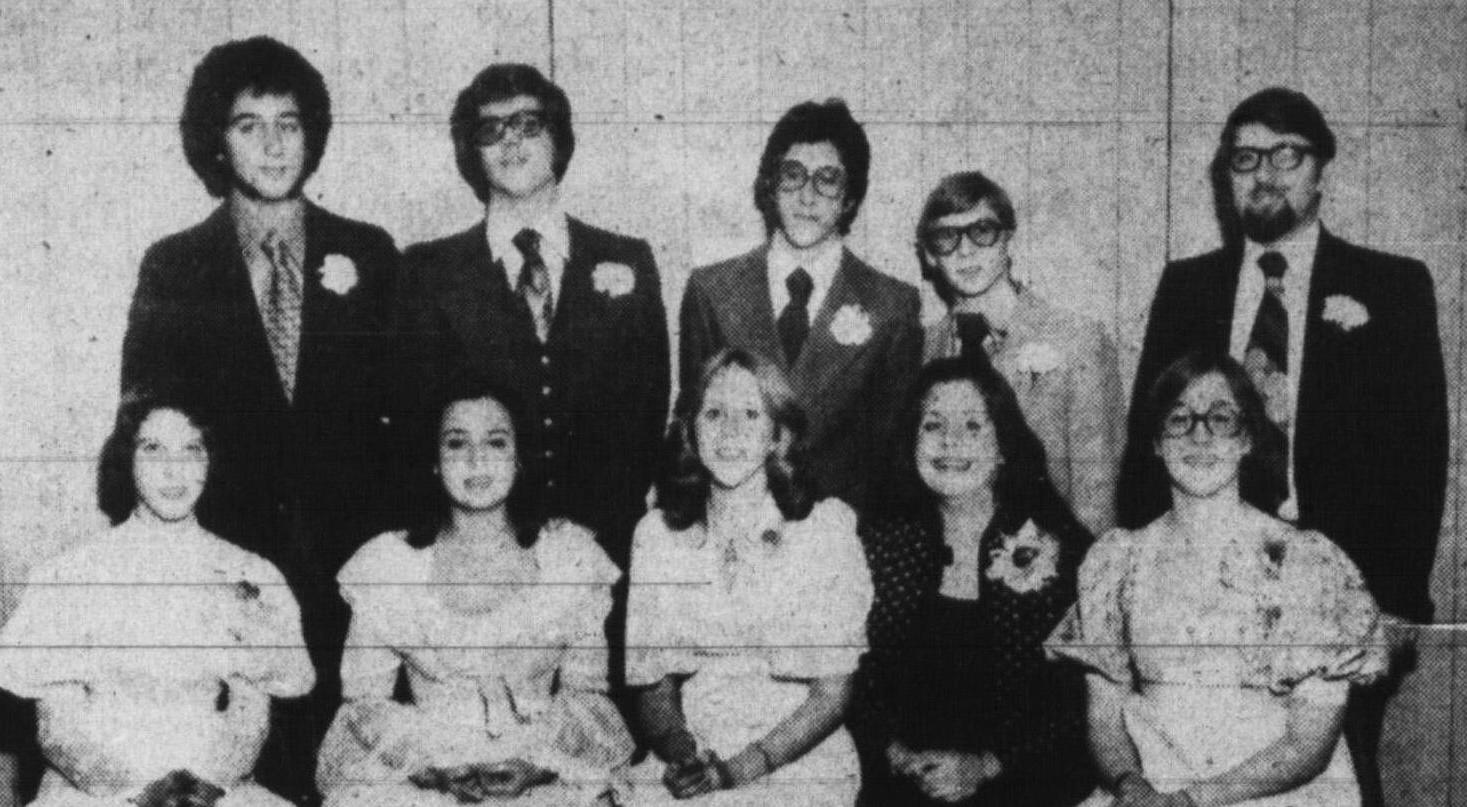
The creation of the Hebrew Academy of Greater Kansas City, now Hyman Brand Hebrew Academy (HBHA), was explicitly endorsed by Chronicle Editor Milton Firestone — he was involved with the school outside of his editorial duties as well. Many editorials by Firestone championed its importance and necessity for furthering Jewish education in Kansas City.
Since 1966, HBHA has been mentioned in The Chronicle more than 5,000 times. Its students, faculty, events, campaigns and more have been regularly covered by The Chronicle, and the strong relationship between The Chronicle and HBHA continues to this day.
Pictured are (left) the announcement of the founding of the Hebrew Academy in 1966, most likely penned by Editor Milton Firestone; (bottom left) the first graduating high school class of the Hebrew Academy in 1976; and (below) the 1978 HBHA graduates.


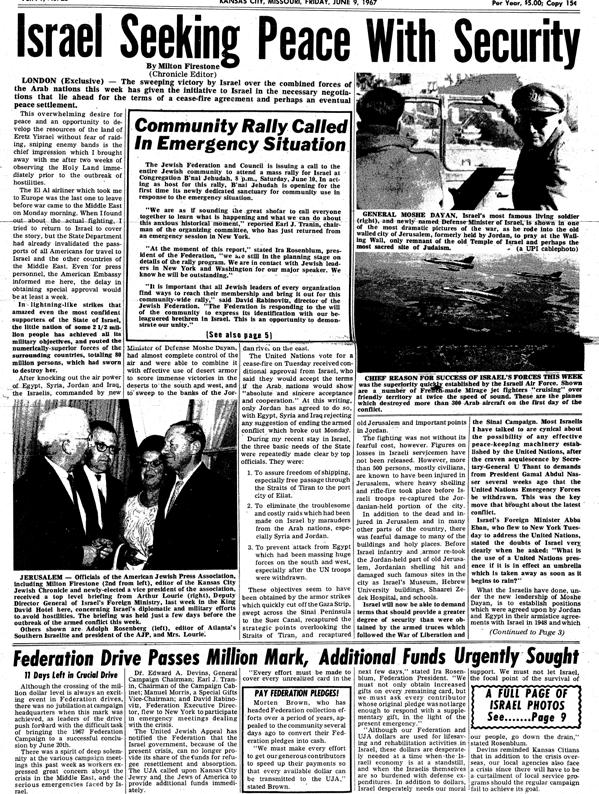



“The Chronicle has been a fixture in my household for over 75 years as my parents also took this paper. The Chronicle has kept me and my family updated in all aspects of KC Jewish community life and beyond. To another 105 years!”
-BobbiArenson(75+years)
For 56 years, the Rose family were instrumental in the continued survival and success of The Kansas City Jewish Chronicle.
Stanley J. and Shirley Rose and their son Steve Rose led The Chronicle in various capacities between 1964 and 2020, holding positions such as president, executive editor and publisher.
Stan Rose and editor

Milton Firestone became co-owners of The Chronicle in 1964. When Firestone died in 1983, the Rose family’s business, Sun Publications, acquired The Chronicle. Both Steve and Stan Rose held the positions of executive editor and co-publisher throughout the late 1980s, with Steve Rose eventually assuming full leadership.
Stan Rose was involved in Sun

“Among the first things we did after our marriage in 1959 was to subscribe to The Kansas City Jewish Chronicle. We did so in order to receive world, national and local news about the Jewish community. No internet or Facebook then. Today, we look forward to receiving The Chronicle both by mail and digitally. Keep up your good work.”
-KathyandBobDeWitt(66+years)

Publications until his death in 1997. His wife, Shirley, who also held many roles at the company, died in 2022. In 1998, Steve Rose sold the company’s publications but remained involved with The Chronicle through various leadership roles. He bought The Chronicle back in 2010, and two companies he led, MetroMedia and
later Rose Publications, stewarded The Chronicle until 2020.
In 2020, Steve Rose passed the reins of The Chronicle to Jewish Federation of Greater Kansas City.
“The history of The Chronicle is intimately tied to those of my family’s,” he wrote in the Sept. 10, 2020, issue of The Chronicle. “Handing over the reins stirs deep emotions and brings tremendous nostalgia, as well as appreciation for everything we have shared with the community we cherish.
“This is tempered by the knowledge that The Chronicle will be in safe, caring hands,” he continued.
“Thank you, Kansas City Jewish community, for everything. It has truly been a pleasure serving you for so many years.”














It’s hard to believe that The Kansas City Jewish Chronicle is celebrating its 105th birthday of keeping our community informed. So many stories, events, activities and simchas have been shared, along with all the people behind them.
I became managing editor in 1987 at the invitation of then-publisher Steve Rose, who needed someone to take the helm when my predecessor, Diane Wolkow, made Aliyah. Steve snatched me away from the world of broadcast journalism, guiding us into a new area of wide community coverage of all things Jewish and beyond. With the largest staff in its history, our team of six covered congregational news, community comings and goings, as well as simchas and deaths. A tremendous note of thanks to that team, which included Barbara Bayer, Rick Hellman, Mark Belingloph, Irene Goldstein, the late Bea Firestone and Sybil Kaplan. In fact, both Barb and Rick would go on to become editors of The Chronicle in later years.
Yet, we expanded our reach by writing stories about Jewish individuals and their impact within the broader Kansas City community. We explored business, cultural arts, food, books, health and more. We had two regular opinion columnists: Rabbi Morris Margolies and Hugh “Pat” Uhlmann, who brought varying perspectives on the most pressing issues facing our community.
Our weekly issues averaged 28 to 32 pages packed with news — local, national and international news from wire services and national columnists. For the holidays, those issues blossomed, with one Passover publication reaching 72 pages, thanks in part to the crackerjack advertising department. Hours were put into each issue, and we tried our best to

be informative and creative.
My tenure was also marked by active involvement with the American Jewish Press Association, where I served as the paper’s representative and was fortunate to attend several meetings and travel to Israel. The paper won several awards from AJPA — thanks to our great team. World events impacted our paper, two of which stand out in my mind. During the first Gulf War, when Iran fired scud missiles into Israel, we stopped the presses as Rick Hellman and I stayed up until the wee hours of the morning redesigning our front page to ensure it was as up-to-date as possible. Freed Soviet Jewish Refuseniks came to Kansas City to visit the congregation that had supported them for so long during their battle for religious freedom — it was a touching moment for so many in the community.
Locally, during my tenure, we worked on a special issue on the opening of the Jewish Community Campus, which has become a fixture of Kansas City’s Jewish community. We also shared the news about the establishment of the Midwest Center for Holocaust Education. Additionally, there was significant news in the
congregational arena when Congregation Beth Torah opened its doors. There were dozens of stories that it was my pleasure to share with our Jewish community. I will never forget seeing the blue numbers on a local Holocaust survivor’s arm as she recounted her personal story of tragedy and triumph. Writing about my first journey to Israel allowed me to share my thoughts and experiences of the Jewish homeland. I had the privilege of seeing then Prime Minister Yitzhak Rabin in his office at the Knesset, as well as welcoming new immigrants arriving at Ben Gurion Airport in the early hours of the morning to their new, free homeland. I conducted interviews with government officials, celebrities and community leaders. I talked with young Jewish schoolchildren at the Hyman Brand Hebrew Academy and with seniors living at Shalom Geriatric Center. There were so many stories to share.
I credit my years at The Chronicle with helping me grow in numerous ways. I attribute my time at The Chronicle to increasing my understanding of a vibrant faith and culture. I learned to bake challah for the first time with a local rabbi’s wife and studied Torah with my colleagues. On a personal note, our daughter Elizabeth was born during my tenure, and I learned to balance a demanding job with parenting young children. I worked alongside my sister, Barb, who was part of the advertising staff, and my mother, Dorothy Baum, worked nearby as the vice president of sales for Sun Newspapers, which owned the paper.
A big thank you to the Jewish community for embracing the paper and our team by sharing the rich stories of our time. Wishing The Chronicle another 105 years of sharing the news of our Jewish community!




Not only was it an honor to be The Jewish Chronicle’s editor, it was a great, fun job.
It was a license to run around town and stick my nose in people’s business. I started in 1988 as The Chronicle’s Business and Arts pages reporter, taking over as editor in 1994. That allowed me to rub shoulders with such eminent 20th century Jewish personalities as Elie Wiesel, Abba Eban and Henry Kissinger. I interviewed Sheldon Harnick, lyricist of “Fiddler on the Roof;” Chaim Topol, who starred as Tevye at Starlight Theatre; Howard Cosell, who spoke at the JCC’s Sportsnite fundraiser; and Kinky Friedman, satirical country singer turned satirical detective novelist.
Local boys who made it big in New York or Hollywood — Ed Asner, Calvin Trillin and Larry “Fats” Goldberg — were generous with their time.
I interviewed the men who created the most iconic Kansas City buildings: Kaufmann Center designer Moshe Safdie and the dean of local architects, and Clarence Kivett, whose Mid-Continent International Airport and Truman Sports Complex defined Mid-Century Modern hereabouts.
Whether it was my late Sun Newspapers colleague, Charles Ferruzza, sending me on movie junkets or performances in Kansas City, I got to interview such Jewish superstars as Woody Allen, Jerry Lewis, Milton Berle, Don Rickles and the Coen Brothers.
I remember hanging out one day at my West Plaza bachelor pad with visiting sculptor Donald Lipski, and another afternoon when I took two Russian Jewish emigre artists the Jewish Federation had brought to town out to a Kansas City Royals game. (They were bored and hated it!)
Far outnumbering the stars were

the hundreds of local artists, business people, civic leaders and others who let me into their lives and trusted me to tell their stories to and for the community. I think fondly of getting to know Lester Goldman, Norman and Elaine Polsky, Cynthia Levin, Allan Winkler, Sybil Kahn, Gail Lozoff, Barnett and Shirley Helzberg, Bert Berkley, Mark Edelman, Dan Jaffe, Stan Plesser, Abe Kopec, Sam Gould and Jan Fichman.
Once, for a story, I spent a night hanging out at the Louis Memorial funeral home with a dead body and a live member of the Chevra Kadisha. Another night I rode dog watch in the inner city with a Jewish KCMO cop.
I got to interview figures who helped the world understand the Holocaust — Nuremberg prosecutor Benjamin Ferencz and psychologist of political violence Robert Jay Lifton. I thank those who later became Kansas Citians and who helped me to understand their experiences at that world-shattering time, including Walter Stras, Geniek Mittelman, Lou Frydman, Frank Szasz, Judy Jacobs and, of course, Big Sonia Warshawski. The Chronicle covered the effort to preserve their stories and those of other survivors through the
establishment of the Midwest Center for Holocaust Education.
We chronicled the Soviet Jewish freedom movement and the emigres’ resettlement in greater Kansas City.
And I got to tell stories of the connections between KC and the Jewish State. I went on two Israel Ministry of Tourism-sponsored junkets: the first in 1996, following riots over the opening of an archaeological tunnel running along the Western Wall in Jerusalem, and the second after the outbreak of the Second Intifada in 2000. I also went on a Federation-sponsored community support mission the following year. I visited KC’s partner city, Kibbutz Gezer, and nearby Ramla with my guide, kibbutznik David Leichman. I interviewed visiting Israeli diplomats and historical figures and spoke in defense of Zionism at a local meeting of the pro-Arab Christian group Sabeel.
There was momentous technological change during my years at The Chronicle, some of it exciting, like establishing the kcjc.com website, and some of it challenging, as we were forced to learn new methods in order to do more with less money.
Above all, serving as Chronicle editor allowed me to form an adult relationship with the man responsible more than anyone else — apart from my immediate family — for forging my Jewish identity, even if I never belonged to his synagogue — Rabbi Morris Margolies. I grew up as a member of Boy Scout Troop 61 and KC United Synagogue Youth, both housed at his Congregation Beth Shalom, and I went on the eight-week 1975 Kansas City Youth Pilgrimage to Israel — a program he established. It was a pleasure to pick up his hand-written columns each week and type them up for Chronicle readers.
Thanks for the memories!










Tree of Life synagogue shooting in Pittsburgh






I fell in love with the Jewish Chronicle while I was in high school in the 1970s. I was an active member of BBYO, and when the paper arrived each Friday, I would check to see what was printed in the AZA/BBG news column. I became a subscriber, which I’ve been ever since, when I started college at the University of Kansas.
The Chronicle had a job opening when I was a new college graduate. However, then-editor Milton Firestone didn’t think my college experience in broadcast news and being a high school journalist matched what he needed in a reporter. Luckily for me it paid to keep up friendships and network, as a high school friend — Ruth Baum Bigus — was the paper’s editor a decade later when I was searching for employment. This time, Ruth and Publisher Steve Rose decided to take a chance on me. In a career that began in 1988 and spanned almost 35 years in either full-time or freelance roles, I served in a variety of capacities for the newspaper, its magazine and special projects including two stints as the paper’s editor.
A lot changed in the publishing world in my career as a Jewish journalist. In the late ‘80s and early ‘90s, using computers was just becoming the norm, and email for everyday use was mostly nonexistent. People who wanted to submit items to The Chronicle either hand-delivered them to our office or sent them through traditional mail.
The popularity and ease of using

the internet, email and 24-hour news channels changed the way we saw, and reported, the news. Our readers no longer depended on The Chronicle to tell them what was happening in Israel, or Jewish communities across the country. In the 2010s, we moved to more opinion-based stories about national and international events since the actual news quickly became old.
Locally, The Chronicle was still the major source of Jewish news happening in our congregations and our organizations, as well as the best way to celebrate our simchas and mourn our losses. All the while — and some undoubtedly would disagree — we did our best to be mindful of our Jewish values when we reported what was happening around us. It was my job to make sure what we chose to write about — and how we wrote about it — was fair, honest, respectful and trustworthy. Tough, and sometimes not popular, choices were occasionally made. Other
times, I felt we weren’t getting close to the real story no matter how hard we tried.
By far the most difficult story I had to report during all my tenures at The Chronicle was the shootings at the Jewish Community Campus and Village Shalom just days before Passover in 2014. It was a national story that literally happened in my backyard. I was able to depend on professional members of the Jewish community, who were also my friends, to help guide me as I determined how to cover this story in our newspaper. At home, my family also lent helping hands so I was able to host a Passover Seder a little more than 24 hours after the tragedy.
I became a bat mitzvah and was confirmed in my youth, but my real Jewish education came as an employee of The Chronicle. I liked learning about my religion and covering Jewish news in Kansas City. What I enjoyed the most was meeting people from the various sub-communities of the Jewish community — from Chabad to Orthodox to Conservative to Reform to those who “just identify as Jewish.” On the other hand, meeting those people could be the most frustrating thing about working for the Jewish Chronicle, as it was often difficult to rush through Hen House on a Friday afternoon without being stopped by someone who wanted to give me a story idea!
One thing is for certain. The friendships I made during my association with The Chronicle are what I cherish most about those times in my life.
